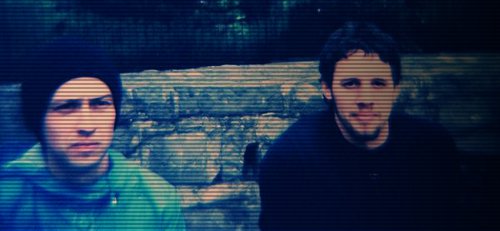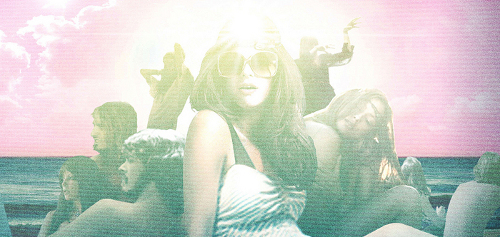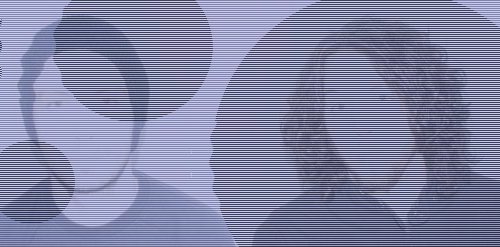
Solar Bears – ‘She Was Coloured In’
Solar Bears are Irish duo John Kowalski and Rian Trench; together they make music that navigates and interrogates pastoral psychedelia, krautrock, kosmiche, drone, and everything in between.
Their synthesis is an organic one, a seamless fusion rendering the gaps between genres and styles incomprehensible and their music timeless. In the distracted world of electronic music, warmth is often neglected in favour of functionality or futurism, and Solar Bears’ lack of concern for either of these allows them to direct their attention elsewhere: namely, to melodies and textures. Their ‘electronic music’ is a different one than that of modern dance music, inspired by the evocative synthscapes of composers like Vangelis and Moroder.
While they are impossible to classify, they seem poised at a precipice, finding compatriots in an ill-defined UK scene that seems interested in exploring the same sort of fuzzy pseudo-nostalgia they espouse. Producers like Lone, Oriol, and fellow Mu upcomers Tropics share in the duo’s love for inviting soundscapes, while artists such as Oneohtrix Point Never, Radio People and Emeralds harbour a similar admiration for the emotional resonance of the synth, though the Bears’ style is slightly more approachable.
Through the interview, one thing becomes clear: Solar Bears exist in their own world, not fussed with the expectations or desires of others. Their only contact with our world is through their records, portals to fantastical dreamscapes that exist entirely in palettes of warm and soothing colours. But no matter how detached they are from our realm, the ‘Bears’ are still human – their preoccupation with film music especially comes through in their use of transparent and straightforward emotional motifs: riffs and melodies that aren’t afraid to be obvious when they need to be, alternately melancholy, maudlin, heartwarming, and triumphant.
Finding a home on the ever-unpredictable Planet Mu, Solar Bears release both their debut EP Inner Sunshine and LP She Was Coloured In this fall. The former is a particularly woodsy affair, prominently highlighting acoustic guitar and synth interplay (and remixes from Lone and Letherette), while the latter is an overwhelming display of hyper-saturated colours and textures, mixing in digital elements effortlessly. They cover a remarkable amount of ground, moving from motorik-powered krautrock on ‘Trans Waterfall’ to the post-rock crescendo of ‘Photo Negative Living’ on the EP, while the LP features the vocodered Black Moth Super Rainbow pastiche of ‘Children of the Times’ and the tunneling disco of ‘The Quiet Planet’ among many other stunning tracks.
“I’ve always wanted to hear new music, new instrumentation and new sounds”
Go ahead and introduce yourself.
“My name is John Kowalski, I come from South Dublin but I currently live in a coastal town called Malahide on the North side of the city. Rian, who co-writes and co-produces Solar Bears, is from Wicklow. He lived in England when he was young and has a very musical background with two parents in the business.”
What attracted you to music and to start making music?
“I’ve always wanted to hear new music, new instrumentation and new sounds. Ennio Morricone was an early favourite and so was John Carpenter. The string arrangements by John Barry for the Bond films made a lasting impression too. I used to hide away and listen to records on my own. I had track ideas I wanted to try out and Rian was up for collaborating; the first effort ‘Trans Waterfall’ went fluidly so we decided to continue. I had no experience making music prior to that session.”
How did you meet Rian and start collaborating musically?
“We met at a recording college in Dublin called Pulse about four or five years ago. I contacted him just over a year ago to work on a track I had worked out in my head with most of the parts mapped out. He records at home, so we simply began one day after I got the train down to where he lives.”
When did Solar Bears begin to exist, and where does the name come from?
“After we had two or three tracks I put up a page on myspace as a catalyst to keep creating. It was mainly as motivation and to make the project concrete. There are a few reasons [for the name]. It was a possible track name and I wanted something plural to represent us. It’s a reference to Solaris by Tarkovsky as well as Native American culture. Furthermore it is a play on words and a metaphor for wildlife dying out because of the sun which is inherent in a lot of science fiction.”
;hl=en_GB” />Loading Video…
;hl=en_GB” allowscriptaccess=”always” allowfullscreen=”true”>
Solar Bears – ‘Twin Stars’ (Lone Remix)
How did you come into contact with Mike Paradinas, and end up working with Planet Mu?
“I followed the normal avenue of sending him six tracks and waiting for a response. He said he liked the music and asked for more. He got back quite quickly so I took that as a good sign.”
Why did you and Rian approach Paradinas specifically – what about him and the label appealed to you?
“I had been looking into different labels at the time and I had a good feeling about them. Before making the decision I watched an interview with Mike on youtube and he came across very well. Quite a humble person considering his position. The label itself is growing all the time which is reflected in the latest signings. I like their overall approach. We had offers from other labels, but Planet Mu was the best place to start.”
Do you feel like Planet Mu is a good fit for Solar Bears?
“I think it’s a good fit, yes. Everyone at the label has been very supportive and easy to work with. They are all straight talkers which is my preference when dealing with people. I try to learn as much as I can from them and ask relevant questions. Common sense prevails which is reassuring.”
So how did your two releases come about?
“After we agreed to work with Mike and the label we kept writing to try out different ideas and styles. Then we tried to make two cohesive collections, and Mike was extremely helpful with this. Both ‘Kill On’ and ‘Photo Negative Living’ were difficult to place on the album as they are quite standalone and stern. I find both of them quite cold in tone, hence the titles. The album is more utopian and dreamlike.”
“Utopian and dreamlike” – did you set out intentionally to create that sort of mood for the album?
“The sound is down to a meager set up and what we had to use at the time. We only had a demo version of a popular program which was literally ten years old. Rian has just built a brand new studio so the next batch of tracks are bound to be produced differently. We really want to get into sampling, and continue experimenting. I would have thought the mood is quite upbeat and celebratory, but then the album closes on a down note.”
Was She Was Coloured In a particularly difficult album to make?
“The songs came quite easily and naturally. Every recording session brought about a new song. Starting out, we just wanted to make tracks that [triggered] a response from ourselves. When the online reaction became apparent we were spurred on to try out new fashions and styles. The sequencing was shared between Rian and I for the most part. Roles in the band are not defined.
“The album format is incredibly important to us. I can’t believe it’s even in jeopardy”
Was there a thought process behind the structuring of the album? Is the album format particularly important to you?
“We intended to end with a summary, or final statement, which is why “Perpetual Meadow” was used at the climax. Mike helped with the track listing a huge amount. He kept working on it until it gelled perfectly. There were various orders but we were all satisfied with the one that is on the LP now.
“The album format is incredibly important to us. I can’t believe it’s even in jeopardy. You get so much from daydreaming to a full record. A good album has the power to make you feel protected or held; it takes you out out the norm, the mundane, and gives you a sense of belonging. My favourite albums would include Loveless by My Bloody Valentine, Screamadelica by Primal Scream, Unknown Pleasures by Joy Division, Low by David Bowie, Ambivalence Avenue by Bibio, Homework by Daft Punk, Dummy by Portishead, Heaven or Las Vegas by Cocteau Twins, Drukqs by Aphex Twin and Dead Cities, Red Seas and Lost Ghosts by M83. The list goes on ad infinitum.
Does the album have any particular concept or theme? There seems to be a particular obsession with colours.
“The album title is about a girl called Abbey — I have learned a lot from her in the past while. Each track is meant to be a facet or shade of a personality which is suggested in the artwork. I have been obsessed with colour for a long time, how individuals choose colour to project an image and how eye colour relates to character types. We wanted colour to be center stage. The theme is definitely about looking back.
Can you shed any light on the significance of the album artwork?
“The artwork is by The Zonders. We wanted to reference technicolor echoes somehow and have a female image. Kenneth Anger is a director I have a lot of respect for, as I think he used colour as a main protagonist. Take the end scene in Electra Glide in Blue, which has the most incredible widescreen shot imaginable, but I always recall the red on his jacket more than anything else because of how vivid it was.
“The grain is due to the fact I like watching films on VHS more than on DVD, and it suits the damaged tape sound of the LP. Primary colours have the greatest impact on the human psyche so we wanted to utilize them as best we could.”
The two remixes on the EP are intriguing. Who chose the remixers?
“I chose the remixers, as I was familiar with their respective work and I admire them a great deal. Having heard their reworks for Bibio, I felt they could bring something of interest to our music. We were very contented by the results.”
What would you call the music you make?
“Admittedly this is something Rian and I struggle with. When you define something it tends to shred it of essence. We listen to countless bands and groups from different generations and that filters through, be it electronic, or indie, or folk.”
Do you consider it ‘electronic music?’
“We use electronic instruments and electronic musical technology so yes, I would say so. The acoustic instruments play a part too and we attempt to utilize both. Many of our favourite bands would be termed ‘electronic’, but sometimes it only matters whether the music is good or not.”
So how do you make it?
“Rian just built a new studio, so this will all change, but for the EP and album we used very old software. Luckily we found old hand held recorders and tape machines lying around the house which we employed as much as possible. The end of the record is actually a My First Sony recorder from 1986 I believe. From a writing point of view we try to get ideas down as quickly as we can and then add to them and enhance them. There are a few vintage synths in the tracks. I do not agree to ruling out either analogue or digital.”
How are the tracks written and built? Do you feel they are complete statements or rather sketches?
“When we start, the only thing we have are ideas and a rough arrangement. If a track goes on a tangent we simply follow to see where it ends up. An end point for us is when a song feels finished, or when we think nothing else needs to be added. Another thing we aspire to do is introduce the percussion later than normal so when it is finally introduced it has more impact and is therefore more noticeable. Drums are taken for granted way too much in music.
“If I listen to them separately, it feels that way [like sketches]. but when we put together the album order they communicated well with one another. Sketches or collages would be a fair way to describe them. There are a couple of vignettes on there which are isolated statements. Our track ‘Division’ is an homage to Ian Curtis; we are both big followers of Joy Division.”
“”I watched Das Boot a year ago on VHS. There was tape hiss non-stop for 3 hours, which was heaven for me”
What are some of your biggest influences?
Film music got to me at an early age. Moroder and Vangelis being prime examples, they got me into synthesizers. For the past decade or so, I would have to say Death in Vegas, Primal Scream, and Bibio.
How did film music in particular impact you and the music?
“Film music made me feel more than things I learned at school, like maths or geography. It was a marriage of watching human characteristics and behaviour with orchestrations and sound design on screen. When we make tracks, they tend to link with fabricated scenarios which are out of our hands. Rian’s father writes music for film and television.
“One of the main things I recall from childhood was watching Watership Down. It changed me: the music, the harshness, the awe, the spectacle. It also conveyed how paramount all life is and how time is not to be taken for granted.”
Do you feel your music evokes nostalgia? Is there something inherently ‘past’ or antique about it all?
“It’s hard to say what nostalgia means to different people. Sometimes it is derived from contentment while for others it can mean deep regret. Everyone holds onto memories, it is inescapable. We get comments how our music is like a seventies or eighties soundtrack they know; some remarks so far allude to John Carpenter and a few pertain to Moroder.”
On that note, do you feel like the sudden obsession with nostalgia and the fetishization of the old is a positive or bad thing?
“There is also a fetish for the past. Each decade takes from the one twenty years previous, thats why this last one had so many references to the eighties. It was no surprise to me lately when a band spoke of their love for The Las.
“I watched Das Boot a year ago on VHS. There was tape hiss non-stop for 3 hours, which was heaven for me personally. High definition seems too clinical too me, the colour is too clear.”
Future plans?
“We have a split release with Fur lined up so we are looking for a label at the moment to work with. It is something we have discussed with him for months and months. Both of us have tracks ready. After that we will probably getting working on a new record. There are plenty of things we have yet to try out.”
Andrew Ryce




































